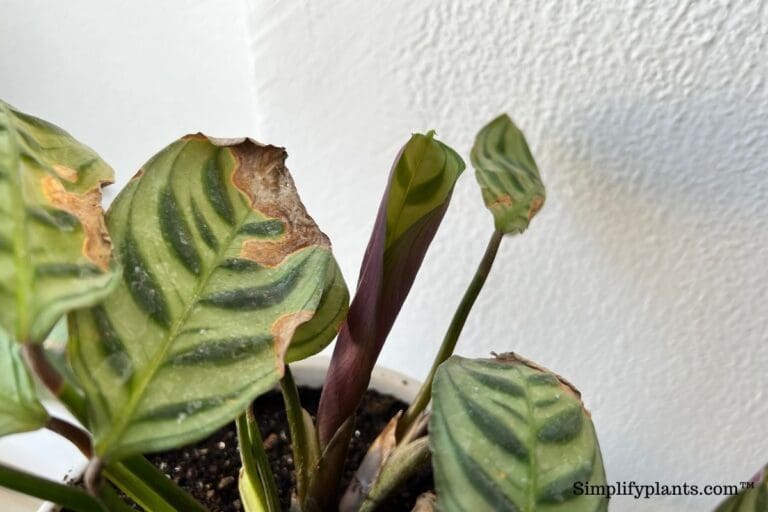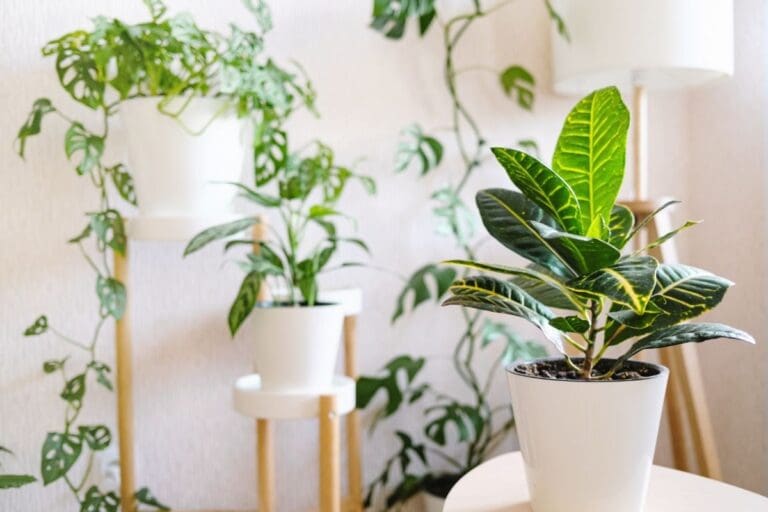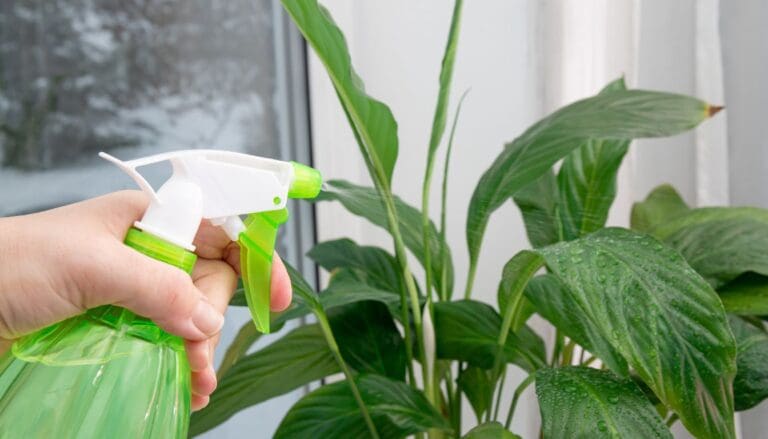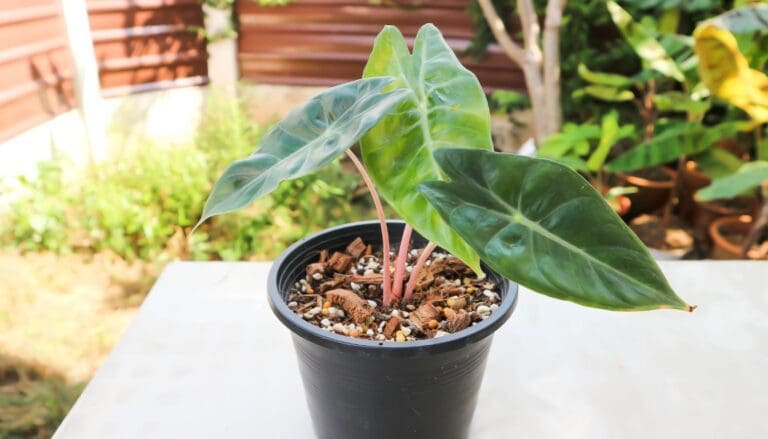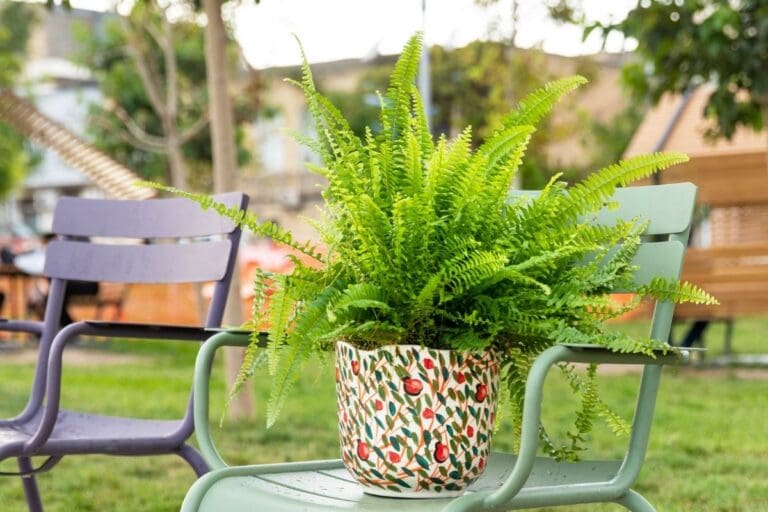Why Is My Croton Not Colorful? (Possible Problems+How To Fix)
Crotons are adored worldwide due to their alluring and colorful leaves. But, what if they are not colorful enough or losing their color? All the gardeners will agree that it is frustrating to see your croton losing its color.
So, in this article we shall learn, why is your croton not colorful and how can we fix the same.
Poor lighting conditions are the primary problem due to which your croton leaves are not colorful. Crotons need a lot of light to perform photosynthesis and maintain their color. Provide bright lighting conditions to your crotons and fertilize the plant adequately to get bright-colored leaves.
In this detailed article, we have provided you with the causes responsible for a Croton that is not colorful and some remedies and tips to maintain the color of this beautiful plant.

Please note: Simplify Plants is reader-supported. Some links in the post are affiliate links and I get a commission from purchases made through links in the post.
Why is my Croton not colorful?
Various reasons are responsible for dull crotons. Owners love their Crotons mainly for their alluring leaves, and it is an absolute heartbreak to see the dull and pale.
Few causes take away the charm and color of crotons. These are:
- Insufficient lighting
- Low temperatures
- Wrong watering techniques
- Improper fertilization
Let’s look at a detailed explanation of each of these issues.
Insufficient lighting

Crotons grow best in bright direct light, and they prefer full sun. The color of its foliage depends on the amount of light it receives.
So, if you don’t keep your Crotons in an area with an ample supply of sunlight, they will gradually lose their colors and turn into a regular-looking green leaf plant.
Also read: What Kind Of Light Does A Croton Need? (Croton Light Requirements )
Low temperature

Due to their tropical origin, Crotons are not cold resistant. They prefer temperatures ranging between 65°-90°F but can tolerate as low as 40°F.
The low temperature encountered by crotons during winter is unbearable for them. If exposed to prolonged cold weather, the plant’s cells get massively damaged, which leads to less color on them.
Crotons losing their color is common during winters.
Also read: What Temperature Can Croton Tolerate? (+Ideal Temperature Range)
Wrong watering techniques

Overwatering and underwatering are two phenomenons that houseplant owners often go through.
Overwatering in Crotons results in yellow foliage. Generally, croton leaves are a mixture of dark red, green, and bits of yellow. But if they are overwatered, the leaves turn completely yellow.
Also read: How Often To Water Croton Plant? (Watering Schedule+Watering Problems)
Improper Fertilization

Although crotons don’t need much fertilization, feeding them well enhances the color of leaves. If your plant doesn’t receive the nutrition needed to grow, it will lose its vibrant colors.
Excessive fertilization sometimes can also lead to discoloration.
Also read: What Fertilizer Is Good For Croton? (Best Fertilizer For Croton Plant)
How do I make my crotons more colorful?
Colorful Croton is the desire of every houseplant owner. To get such beautiful crotons, you need to consider a few points.
Crotons are grown for their attractive foliage. To restore the charm of those extraordinary leaves, one should take proper care.
The steps to make your Croton look more colorful and retain the colors are:
- Maintain proper lighting
- Take care during winters
- Follow a proper watering technique
- Fix the soil
- Avoid unstable temperature
- Sufficient fertilization
- Cure pests
Now let’s get into the details.
Maintain proper lighting

Crotons prefer full sun, and if not provided, they tend to lose their shine. They come out with their best colors when placed in direct sun.
Due to the difference in the pigments present in their leaves, the light requirement of Crotons is different from many other houseplants. The light requirement also depends on the kind of Crotons available in the market.
You should know under which kind your plant falls, and it will help you understand the lighting your plant requires. Keep the Crotons near a window or in a place to receive uninterrupted direct sun rays.
We will personally recommend croton owners transfer the plant into a low light area during the summer afternoon. They can tolerate moderate to high bright daylight.
We agree that crotons love the direct sun, but too much exposure to the rays can cause sunburn.
Take care during winters
Winters are brutal for crotons. They belong from topical origins and still can tolerate temperatures as low as 40°F. But extreme low temperatures lead to a dull and faded croton plant. So, during winters, they need proper care to maintain their colors.
To protect them from the cold, transfer the plant to a relatively warmer place. Room heaters with a suitable temperature can also serve the purpose.
And never keep your Crotons outdoor or near an open place overnight. The cold will be unbearable.
Follow a proper watering technique

Crotons are moisture-loving plants like many houseplants. They thrive best in moist conditions. They prefer their soil and environment to be filled with moisture.
Therefore, they demand frequent watering, keeping their soil moist to meet their water requirements.
Often Crotons undergo problems due to overwatering. So, before watering your plant, check the soil. Stick a finger into the soil to ensure that it is dry enough to take more water.
Overwatering is also responsible for your Crotons not being colorful enough. But keep in mind that to avoid overwatering, don’t make your Crotons experience underwatering.
You can avoid underwatering by checking the soil at regular intervals. If the foliage is wilted and weak, possibly the plant is underwatered.
Fix the soil
Crotons can sometimes be very demanding. They show tantrums if they are not provided with a soil mix of their suitability.
Crotons require heavy, rich soil. It thrives well in soil that combines organic compost and peat moss. The soil should also drain water well as crotons hate to be drenched in water.
They prefer soil with a slightly acidic pH (pH between 4-6.5 on the scale). Generally, regular soil retains a pH value between 6-6.5. To make the soil more acidic, one can add sulfur and acidic liquid feeds.
Also read: What Kind Of Soil Does A Croton Need? (+Ideal Soil Mix & Requirements)
Avoid unstable temperature
Crotons tend to stress out if they experience an unstable temperature. Stressing a plant may lead to several issues.
Always try to keep your plant in a place where it can enjoy a stable temperature. Never place your plant near an air conditioner exhaust, and frequent transferring the place of your plant should also be avoided.
Sufficient Fertilization

Fertilizer accelerates the growth rate in plants. In crotons, proper fertilization can also enhance the color of the leaves. Sometimes due to insufficient nutrition, the color of leaves fades away, making them dull.
Granulated fertilizer with an NPK ratio of 3:1:2 can make your Crotons colorful and healthy. Fertilizers also depend on the soil quality of your plant.
Scatter the granules of fertilizers on the topsoil, then water it to release the granules into the soil. Never fertilize Crotons during winter as it will harm them.
Before adding fertilizers, it is better to do thorough research on the kind of plant you own and the quality of soil you are using.
Cure pests
Generally, Crotons are not affected much by pests. However, common pests and bugs like mealybugs, scales, spider mites, and thrips can attack Crotons.
Here are a few methods to eliminate pests:
- Dip cotton swabs in alcohol and wash away all the visible bugs and pests.
- Add one cup of rubbing alcohol with a few drops of mild dish soap in water and spray it over the whole plant.
- Use non-toxic pesticides to get rid of pests.
- Add neem oil with mild dishwasher soap and mix it in water. Spray the mixture all over the plant.
- Repeat this twice a week until the issue is gone.
Why is my Croton green?

When the leaves are just growing, they are naturally green. Then while maturing, it turns yellow and later into darker colors. If you find that your Croton is only green, don’t worry.
The new leaves of Croton are generally green with bits of yellow in the veins. Gradually while maturing, the leaves turn darker.
The green color of the leaves has a higher percentage of chlorophyll in them. They change into darker shades of red, orange, and purple after maturing.
So, if your croton plant is only green, then assume that the leaves are just maturing. In the initial growing phase, plants need more energy to grow.
How to take care of Croton plants?
There are a few steps that can lead to vibrant and colorful Croton.
- Place your pot of Croton in such a place where it will receive a good amount of direct sun rays.
- To avoid sunburn or fading of colors due to scorching sun rays, place it under a bright but indirect light when required.
- Try to give less stress to your plant. Crotons are sensitive to temperature changes. Fluctuating temperatures can stress your plant and cause moderate to severe damages.
- Take proper care during winters. Winters give a difficult time to crotons as they can not tolerate temperatures below 40°F.
- Feed your Croton plant once a month. It will provide a good supply of nutrients which will further enhance the color of the leaves and increase the growth rate.
- We recommend urgent repotting if your Croton is root bound or experiencing root rot. A rich soil mixed with organic compost and peat moss is what crotons prefer.
- You should water your Crotons frequently but be careful not to overwater the plant as it may cause root rot and yellow foliage.
Reference: Sciencedirect, Wikipedia, Wikipedia, Britannica, CABI, Academia, University of South Florida, The University of Georgia.
Recommended Garden Supplies
| Product Image | Our Recommended Gardening Supplies | Check Offers! |
|---|---|---|
Top Top
Top
Top
Top
Top
Top
Top
Top | rePotme Houseplant and Tropical Classic Potting Soil Mix | Check Offer On Amazon |
 Top
Top
Top
Top
Top
Top
Top
Top | Espoma Organic Indoor Plant Food | Check Offer On Amazon |
 Top
Top
Top
Top
Top
Top
Top
Top | GooingTop LED Grow Light 6000K Full Spectrum Clip Plant Growing Lamp | Check Offer On Amazon |
 Top
Top
Top
Top
Top
Top
Top
Top | Soil Moisture Meter | Check Offer On Amazon |
 Top
Top
Top
Top
Top
Top
Top
Top | Govee Hygrometer Thermometer, Bluetooth Enabled! | Check Offer On Amazon |
 Top
Top | LEVOIT Humidifiers for Large Room(Best For Plants) | Check Offer On Amazon |
 Top
Top
Top
Top
Top
Top
Top
Top | Upgraded DIY Automatic Drip Irrigation Kit, 15 Potted Houseplants Support | Check Offer On Amazon |
 Top
Top
Top
Top
Top
Top
Top
Top | Stainless Steel Heavy Duty Gardening Tool Set | Check Offer On Amazon |
 Top
Top
Top
Top
Top
Top
Top
Top | Bonide Insecticidal Soap | Check Offer On Amazon |
 Top
Top
Top
Top
Top
Top
Top
Top | Bonide 32 oz Spray Neem Oil for Organic Gardening | Check Offer On Amazon |
 Top
Top
Top
Top
Top
Top
Top
Top | Garden Safe Fungicide | Check Offer On Amazon |

